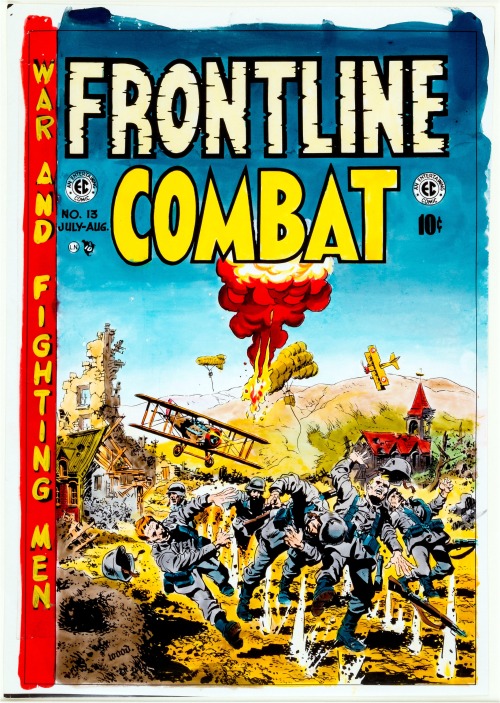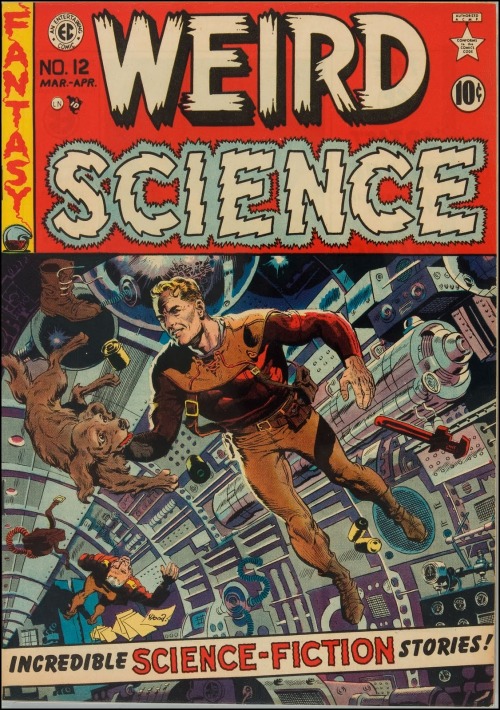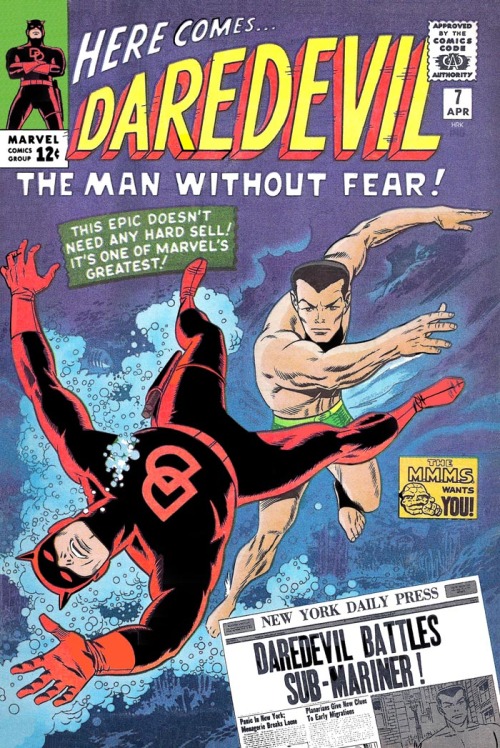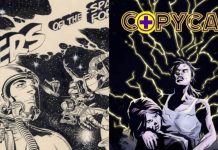EDITED: The above has been corrected to reflect that it is the Wallace Wood Estate in the form of WWP, LLC which is suing, and not the individual, J. David Spurlock.
Here’s one of those matters where there are really no winners. The Wallace Wood Estate, which is administered by J. David Spurlock, the publisher of Vanguard Publishing, is suing Wood’s ex-wife Tatjana Wood, for the possession some of 150-200 pages of Wood art. According to the complaint, the pages are worth between $2000-25,000 each.
Wood is of course the much beloved artist of many EC, MAD and Marvel comics, including Daredevil, and then Witzend Cannon, Sally Forth. He took his own life in 1981, embittered by failing health and career setbacks. Despite that his imaginative and finely rendered art continues to be among the most iconic (overused word I know but it really fits) in the comic book world. He’s also the creator of the”22 Panels that Always Work” piece which is widely copies and referred to.
Wood left a will leaving his money to Tatjana, but his possessions—including artwork and publishing interests—to his friend John H. Robinson. In 2012 Robinson assigned all his interest in Wood’s estate to Wallace Wood Properties, LLC, a company run by by Spurlock, whose interest in Wood includes co-authoring the book Wally’s World: The Brilliant Life and Tragic Death of Wally Wood, the World’s 2nd Best Comic Book Artist.
In court documents, Spurlock says he and his lawyers made many attempts in person and by letter to get Tatjana Wood to give them the artwork, which court documents say was erroneously returned to Tatjana’s home by Marvel, who thought her address was the proper one for returns. (Wally Wood died in LA.)
The court documents, shown below with addresses redacted, lays out a paper trail suggesting that remaining Wood artwork should go Robinson/WWP.
Wally Wood was married three times, and he and Tatjana divorced in the 60s. She continued to work in comics as a colorist for years, however, and back when I worked for Vertigo she would still come into the office. It was always a pleasure to talk to her and learn a bit of comics history.
I’m no expert in Wally Wood, but I’m sure some of you comics historians out there will have some ideas about all of this. And then a little more Wally Wood art to remind you why he’s so revered.
Click to access Wallace-Wood-Properties-LLC-v-.pdf











At least Wood had the good sense to have a will. It’s a shame ex’es can pop up long after the fact to try and loot the estate.
I am not a lawyer. I am not interested in taking sides.
But having read the suit, I’m not 100% sure that the estate can win this suit. The artwork probably wasn’t covered in the original estate calculations because it was done as work-for-hire. And while the will called for everything that wasn’t related to WW’s finances to go to John Robinson, the wording specifically mentions royalties, not the physical art that he created and then sold. Is that art part of his estate?
Marvel may have erred in giving Tatjana the artwork, but once it did, I don’t know if that retroactively becomes part of the Wally Wood estate, rather than a gift to Tatjana herself. Marvel’s intent might have been to give it to Tatjana because she was believed (erroneously) to be in charge of the estate, but if they gave it to her- if the package has her name on it and not the Wally Wood estate, and Wood never had a legal claim to it while he was alive, is it now really part of the estate?
This would be very different if this was creator-owned artwork. But it isn’t- it’s WFH art pages. As such, at the time of sale, it was assumed Marvel owned the physical artwork. Only later was it realized that Marvel only owned publication rights, and not the physical artwork itself. It’s very curious that they made an effort to return it in 2005, decades after Wood’s death, with no known legal action pending from Wood’s estate against Marvel.
It’s going to be very interesting to see how the court ends up ruling on this. If this was about any intellectual property that Wood created at Marvel, the estate would (IMHO) be 100% in the right. But this is about the physical artwork that was given to Tatjana, even erroneously. I hope a settlement comes out of this that leaves both parties in good shape, but who knows.
Also- that’s a LOT of artwork. Wood at most only worked on 30 Marvel/Timely/Atlas books, according to Wikipedia, and a lot of that was as inker only. Compare that to when Kirby tried to get his art back- despite creating thousands of pages for Marvel, he might have gotten back even less that Wood did! (I know the initial offer was only for 8 books worth of material from Marvel, but I’m betting that grew later.)
This is a very curious story.
Man, Marvel’s art return must have been more messed up than we knew. In addition to the lax security that allowed the most valuable pieces to be stolen or destroyed, in addition to trying to use the promise of the return of a fraction of his artwork to coerce Kirby into signing away his right, now we find out that they held on to Wood’s artwork until 2005? And from prior court cases we know that they were still “finding” Kirby artwork as late as 2010 (at least 60 pages). I wonder what other stories there are (I remember hearing once that a large amount of artwork from one deceased creator was just dumped rather than trying to find the appropriate heir).
Spurlock’s claim sounds a bit iffy to me.
First, he mixes up supposed (though not documented) recent art returns with “old art” that Tatjana Wood MUST have received from Wallace Wood BEFORE he died. That means he has no specific knowledge of what was supposedly returned in 2005.
For all we know there might be a misunderstanding where Marvel had pages owned by Tatjana Wood on loan for some other reason.
He also fails to acknowledge that there is a difference between Wallace Wood assigning rights in his will and John H. Robinson signing over rights while alive in return for a specific “amount” (even if it’s just copies of future books by Spurlock about Wallace Wood).
Robinson could only sign over rights to things he KNEW that he owned. For anything beyond that there would be no proper meeting of the mind. It is possible that Robinson might have had a claim, both as executor and as beneficiary, to have a say in the disposition of newly discovered assets.
It is not, however, a given that Spurlocks rights would be the same.
If Spurlock also took over the responsibility of executor of the estate (which appears to be the case), his responsibility might actually be to determine what, if anything, was returned in 2005 (which information he as executor has legal standing to secure from Marvel directly, so that the complaint could be specific and not overreaching as it appears to have been here).
Once secured, however, Spurlock might be in the position where his duty as an executor would be to hand the pages over to John H. Robinson, not himself. Because Robinson as beneficiary did not know that those pages were a part of the estate when he signed his interests over, and there could be no meeting of the minds as to whether those physical pages were included in the sale/transaction.
This even moreso as Spurlock estimates THE value of the (150-200) pages at 2 to 25 thousand dollars each (perhaps not unrealistically so). This translates to a value of between 300 thousand and 5 million dollars, that Robinson supposedly signed over to Spurlock in return for copies of a few 50 dollar comics biographies?
As executor of the estate, Spurlock would be bound to protest that an unexpected valuation of unknown assets of in such amounts would require a judgement call by the executor not just to safeguard the interests of the beneficiary Robinson, but also to determine how Wallace Wood might have disposed of his assets differently between Robinbson and Tatjana Wood if he had known of values between 300 thousand and 5 million.
Would he still have awarded Robinson all artwork or would he have divided it between the two if he viewed the artwork as valuables in their own right? A look at the original will would suggest that monetarily the bequeaths were similar, and that assignment of publishing rights and artwork was more intended for keeping his creator owned work in print than for enormous profit, and that sale of other possessions could be part of that.
It appears at least that Spurlock is mixing roles here, and I think that if this actually goes to court then the court might appoint a different interim executor (or the judge act as de-facto executor himself) to review the “newly discovered assets” and dispose of them according to the intent of the will.
Which might not go in Spurlock’s favor at all.
And it may not even go that far as Robinson might still be the interested party as orginal beneficiary here, and Spurlock is suing as if he’s the beneficiary, not the executor.
Inheritance is messy.
So (quoting from the court document above) John Robinson signed over all “interest in the work, property, copyrights, trademark rights and royalties” to Spurlock’s company. He was paid with the promise to receive “duplicate copies of any publications made” by Spurlock’s company WWP “subsequent to the date of this assignment”. That is, he was not paid at all, and at best (at some undetermined point in the future) with perhaps $100 worth of hypothetical merchandise which at the time did not exist.
This looks bad even before the lawsuit against Tatjana Wood for original art worth several hundred thousand dollars, which Spurlock now claims is included in the assignment.
Spurlock says (in the document) that he “became aware” of the 150-200 pages of Wood artwork in possession of Tatjana Wood “while working on a biography of the life of Wallace Wood called ‘Wally’s World'”. The book was published in 2005. WWP was established in 2011. The Robinson assignment was executed on February 23, 2012. At this point, Spurlock was aware of the potential value (“between $2,000 and $35,000 per page”) of the artwork in Tatjana Wood’s possession. Yet Robinson was paid, in essence, nothing.
This is just from reading the court document, which may not reflect the entirety of the business proceedings.
But the assignment and the consideration given according to the court document appears to be so obviously one-sided that in some jurisdictions its legality would be open to question.
It would be worth some research to find out more about how this deal was made, and if Robinson was aware of what he was signing over.
Spurlock is a skunk, He swindled the estate from Jack Robinson for nothing, then screwed Bill Pearson out of his decades-long job of administering it. He apparently got tired of strip-mining and re-packaging public domain material (cheaply and badly) and figured Robinson to be a ripe pigeon he could use to get his hands on the good stuff. He has relentlessly and brazenly attempted to monetize anything and everything of Wood’s that he can exhume. He’s a grave robber.
Odkin is on the mark.
“The above has been corrected to reflect that it is the Wallace Wood Estate in the form of WWP, LLC which is suing, and not the individual, J. David SPurlock.”
Since the “Wallace Wood Estate” consists of Spurlock and only Spurlock, it comes out to the same thing.
This story bothers me to no end. It takes me right back to the frustration I had when Koch stole all of the ket Kirby and Ditko stuff from the Marvel Warehouse. Every Ditko Spiderman page out in the marketplace was stolen by Pete Koch. And so on. I consider Pete’s theft of the Marvel art the biggest art theft in American history. I am not joking. As an example, what will pages from the first four Spiderman books bring when he finally does find a weasel to start leaking out pages from them one at a time? And to Tatjana goes my sympathies. She is in her 80’s now. Leave her be. Spurlock should try to make money in other ways. He is the estate and if he is able to get his greedy hands on this art he will immediately start selling it. Daredevil 7 pages will start showing up for 50K each. When will the comic greats and their families finally be protected from the Spurlocks and Kochs of the world?? Ken Gerber
When was the artwork in question made? If it was when they were married, Tatjana might arguably have a claim to it as marital property – in other words, she would have been the co-owner with Wally. A policy question that should come into play: should the estate get all the benefit of Wally’s and Tatjana’s not being aware that Marvel held original art that should have been given to them when it was made?
And yes, the original will was badly worded.
Comments are closed.